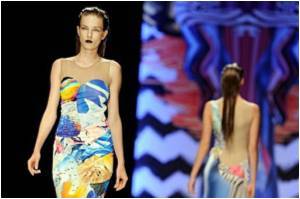So-called plus-size models are a growing presence on magazine covers, television and lingerie catalogues -- but at the Fashion Weeks of New York and London they are still the exception.

British designer Mark Fast introduced shows last year in which the models were all above a British size 12 -- an eight in American sizes -- following criticism that his dresses were too skinny.
And at New York's Spring-Summer 2011 Fashion Week this month there was a special show for plus-size women, billed as the first of its kind at a major fashion event.
But that event took place on the fringes of the major designers' shows, demonstrating that slimline is still the rule when it comes to haute couture despite the heated debate about underweight models.
"Every year I watch the shows and I hope to see it, you know, 'is she a size 12, is she that little bit bigger?' and so far every year I've been a little bit disappointed," said Sarah Travers, head booker at Hughes Models 12+, a specialist in plus-size models.
"For 20 years we've been promoting the plus-size model and the plus-size woman, but the average size of the UK woman is a 14-16 and we've always felt that the fashion industry has been very slow in picking that up."
Advertisement
When Australian Cheryl Hughes founded the modelling agency a quarter of a century ago, she was a pioneering figure. Nowadays, "plus-size" agencies and their clients are starting to flourish.
"We are getting more editorial work and more of that high fashion work, which is great, but it still needs to get a bit bigger and we need those high fashion brands catering for these beautiful curvy women."
The move towards more generously sized models has accelerated since the death from anorexia in 2006 of Brazilian model Ana Carolina Reston, which shocked the fashion world.
Spain and Italy banned models below a certain body mass index after her death, while Britain stopped short, banning only those aged under 16 from the catwalk.
"Sixteen corresponds to a level of maturity," said Caroline Ruth of the British Fashion Council.
For Cheryl Hughes, however, it is between the ages of 16 and 20 that models are most at risk of succumbing to the pressures of the industry.
"It's partially the fault of the modelling industry picking girls of 15 or 16 at the door of schools. When the skinny child grows to woman size they have terrible things to come through. Lots of girls don't cope with it," she said.
In 2008, British model Katie Green launched a "Say No to Size Zero" after her agency told her to lose 12 kilos (26 pounds) in weight, winning the support of many in the fashion industry.
"I think the size zero is horrendous. We had many casualties from that. It's very, very sad," said Travers, of Hughes Models +12.
"I think the move from that is a big start. Progress in the high street will filter on to the catwalks".
Source-AFP









